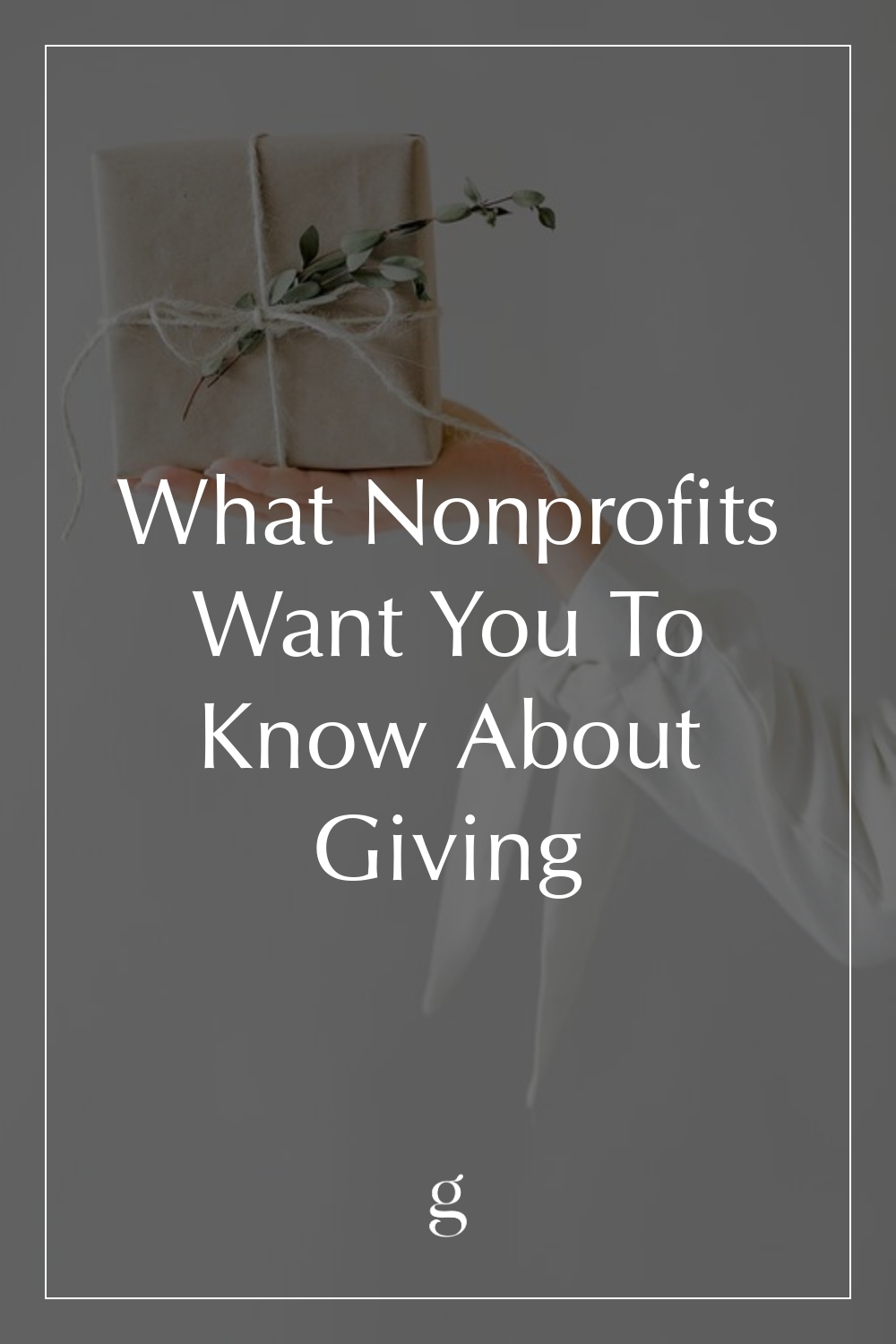
What Nonprofits Want You To Know About Giving
Can I Really Make A Difference?
From my teenage days in Girl Scouts (a Gold Award recipient, ha!) to a young adult who volunteered on dozens of causes, I have always considered myself a “changemaker.” And for the last seven years, I’ve worked as a nonprofit professional. In all that time, the question I hear most from family and friends is, “How the heck should I give back?”
So when it comes to making a meaningful difference for whatever it is you care about, whether that’s fighting breast cancer, working with rescue animals, or eradicating poverty, I’ve got the comprehensive guide for you. Here’s what you need to know—from a nonprofit insider—about making the biggest impact you can this year, and beyond!
What does it mean to “create impact?”
Creating impact is deeply personal, and can span from serving a single meal to enacting climate-centered policies. At the end of the day, making a net-positive impact in some way is more important than doing nothing at all, in whichever way is most aligned with your values and vision for the world.
“How can you play a part in making impact happen?”
Start by considering the issues you’re best positioned to contribute to. This is your “North Star,” according to Impact authors Tammy Tibbetts and Christen Brandt, and your North Star will help you in creating a reasonable and ongoing action plan to make an impact that matters to you.
Tibbetts and Brandt, who co-founded the global girls’ organization She’s the First in 2009, write: “The goal is that your Impact Plan becomes a living, breathing document that you can hold yourself accountable to and check in with yourself every three to six months. On those days when you feel like the world is falling apart, and you feel powerless to do anything about it, just look at your Impact Plan. It’s a reminder that what you do matters, and as part of a much wider movement, you can and you will leave the world better than you found it.”
Maybe for you, impact looks like “I want to see a world without violence against women” or “I believe every animal deserves to be loved.” How can you play a part in making this happen? Once you have this plan in place for yourself, you can then apply it to your giving throughout the year to maximize what you most want to see.
Which nonprofit should I support?
Chances are, you’ve heard of nonprofits like the Red Cross, Salvation Army, or Habitat for Humanity, particularly because they have a national or global presence with dozens of branches. But there are also hundreds of nonprofits and mutual aid organizations right where you live, and it’s overwhelming to know where to begin.
“When you give to a smaller nonprofit, your dollar stretches further.”
That’s actually why I recommend supporting local or grassroots organizations as much as possible. When you give $5 (or any amount) to a smaller nonprofit, your dollar stretches further and most likely reinvests in your local community or a specific group of individuals. With larger organizations, there can be many levels of bureaucracy and red tape, and you may never get to know the impact you’ve made.
If you’re unsure which ones are the most reputable, you can search for reviews online via Google, Yelp, or social media, or turn to directories like Guidestar by Candid or Charity Navigator. For those larger directories, it may be hard to “vet” a small organization that’s just starting off. If an organization doesn’t have years of tax forms and documents, word-of-mouth can actually be a more powerful tool.
Most importantly, give to organizations whose values align with yours. When I was young, I distinctly remember asking my parents if we could sign up for one of those “sponsor a child” programs, where “for just 25 cents a day, you can save a child’s life.” Today, I realize how this was the White Savior Complex (“the self-serving assumption among white people from developed nations that they should be saving poor people”) at play, and that this isn’t the progressive kind of work I want to amplify.
“No matter the struggle, everyone deserves to be seen with dignity.”
Instead, it meant more to me to focus on ethical, empowering storytelling—rather than “poverty porn.” Poverty porn is an exploitative approach featuring photos of people in tattered clothing or impoverished conditions as a way to elicit intense emotional reactions—so you feel more compelled to give (a la the White Savior Complex). However, it portrays people—especially children—at their worst rather than looking at what is possible for their future. No matter the struggle, everyone deserves to be seen with dignity and to have privacy for life’s toughest moments, rather than being exploited.
For your own values, this could be about ensuring that diverse BIPOC or LGBTQIA+ voices are represented through the organization, or that local leaders are the ones doing the work rather than outsiders. Whatever they are, take a few moments to do your own vetting and see if they are actively supporting your vision for the world or hindering it.
Where does my money go?
One of the most common myths to clear up is that $5 won’t do much good. Many nonprofit experts, like Tibbetts, actually argue the opposite.
“Monthly giving is the best way to maximize your impact, especially with smaller contributions,” she says. “We’d much rather receive your $5/month commitment and have you as a member of our community, than receive a one-time $50 donation.” Recurring donations allow nonprofit organizations to plan for the future. Tibbetts compares it to a personal budget, explaining that “you can book a vacation or make any other sort of big life plans when you know what your consistent income is going to be.”
“Recurring donations allow nonprofit organizations to plan for the future.”
When you do give to an organization, your donation is typically split between overhead (like staff time/salaries, office rent, etc.) and/or the “services” that help the community. Oftentimes, you’ll hear that nonprofits with high overhead costs are inefficient or not worth supporting—but that’s not the case. It’s easy to say, “I want 100 percent of what I give to go towards the cause,” but if no one funds the staff or space to make them happen, then no impact can be made.
“It’s really important to value the expense of staff time and ‘overhead’ that makes the outcomes of the organization possible,” shares Tibbetts, who has more than a decade of experience under her belt. “Trust that they will make smart decisions, because they live and breathe this work every day.”
“Trust that [nonprofits] will make smart decisions, because they live and breathe this work every day.”
And sometimes when giving, you’ll be asked which program or geographical area you’d like to support. If you choose one in particular versus the greatest area of need, then legally your dollars are required to support that specific program.
For example, if you give to your alma mater and designate it to a scholarship fund, they are mandated to allocate your donation there. While that can feel like a more personal way to give, it is often more effective to give to the greatest area of need as identified by the organization, which may have more pressing fires to put out.
Once you’ve given, whether it’s one-time or on an ongoing basis, stay up-to-date with their work. You can give them a follow on social media, sign up for their newsletters and stories, or check your year-end receipts for updates. Building that relationship makes your support even more meaningful!
I can’t give money—how else can I help?
Money isn’t the only thing nonprofits need or want—there’s also always time and energy! Your voice is a powerful tool you can use to recruit support for your cause. Ask any crowdfunding campaign or look at the ALS “ice bucket” challenge which raised $115 million to see how effective raising awareness can be.
Here are some other ways you can support without making a donation of your own:
Host an online fundraiser in honor of your birthday or other milestone and invite your loved ones to give. You’ll be surprised how much you can raise with just a few reminders. Over the years, I’ve raised more than $15,000 just by casually posting on Facebook for causes I am dedicated to!
Shout out nonprofits on social media, Google, or Yelp and help build their credibility and reputation. Every positive mention can create a snowball effect of worthwhile attention.
Give “in-kind” to a local organization instead. Many nonprofits may prefer actual goods like wipes, clothes, or non-perishable goods, and they’ll publish “wishlists” of their most urgent needs. See what you might already have or can donate even if it’s gently used (keeping in mind any hygienic limitations).
Volunteer your time and skill set. Organizations can be overwhelmed by volunteer requests, but don’t have the time to vet or work with them individually. Tibbetts encourages us to figure out what you can do best, do some research, and pitch a project to them instead. “Nonprofits need all sorts of skills and connections to accomplish their goals,” she shares. “Be upfront about what you can contribute so they can match you with their needs.” An example could be using graphic design or writing skills for a flyer or blog post, or starting a new music volunteer program if you’re an artist.
No matter how you decide to “give back” using these tips, it will likely make a positive difference. So go ahead and unleash that inner changemaker, you! We can’t wait to see what impact you create in the world.
Do you have more questions about how to support nonprofits? Drop them in the comments!
Henah Velez (she/her) is an Editor at The Good Trade. She holds a Master’s in Social Entrepreneurship and is a proud Rutgers grad. Originally from NJ, Henah’s now in Santa Barbara, CA, where she loves shopping small, hanging with her pets, or traveling. Say hi on Instagram!






